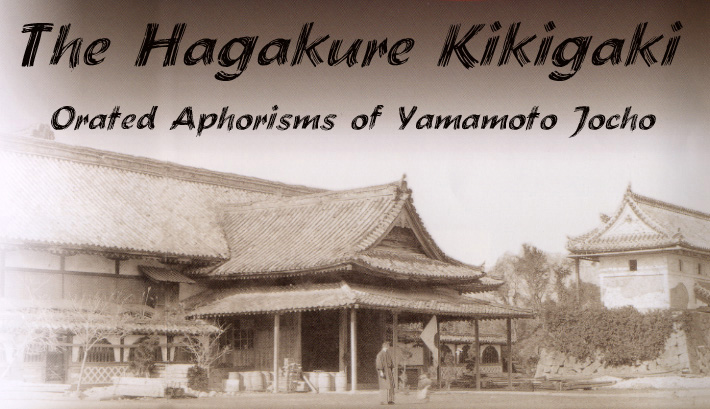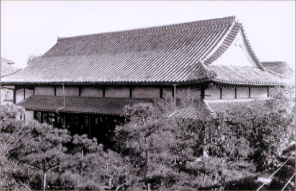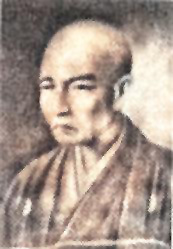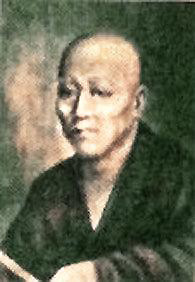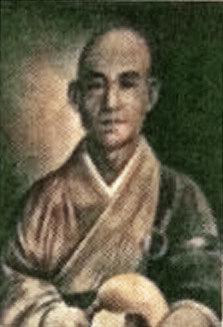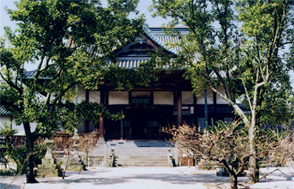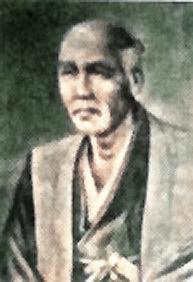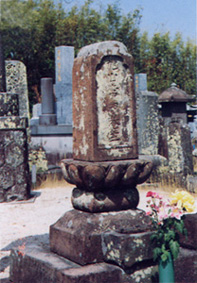Nabeshima Jo -Honmaru Bushido as an independent code of ethics may vanish, but its power will not vanish from the earth; its schools of martial process civility. Honour may be demolished, but its light and its glory will long survive their ruins. Like its symbolic flower, after it is blown to the four winds, it will still bless mankind with the perfume with which it will enrich life. Ages after, when its custom will have been buried and its name forgotten, its fragrance will come floating in the air as from a far-off, unseen hill, “the wayside gaze beyond”; - then in the beautiful language of the Quaker poet, “ The traveler owns a grateful sense of sweetness near, he knows not whence, and pausing, takes with the forehead bare benediction of the air. - Inazo Nitobe (Bushido- The Soul of Japan, New York 1905)
YAMAMOTO TSUNETOMO This man was born on June 12th 1659 in Katatae, an area of the Nabeshima fief. This is about ten minutes walk from the castle. Nowadays both Katatae and Nabeshima are part of 104 year old Saga City. A city that of course covers a wider area. Although much of the old town remains intact.
His introductory words to Hagakure are: The wonder of being born into a clan with such a deep pledge between master and servant is an inexpressible blessing, passed down thorough the ages.......Although it is unfitting of me to say this, in dying it is my hope not to become a Buddha. Rather, my will is permeated with the resolution to help manage the affairs of the Province. Though I be reborn as a Nabeshima samurai seven times. One needs neither vitality nor talent. In a word , it is a matter of having the will to shoulder the clan by oneself.Nowadays it is difficult to deeply understand the essential attitudes fostered by the Samurai caste. However being in the presence of a real Japanese sword, even more so if it is pointing at you and it is in the hands of a well practised master can give one an idea of the strength of mind the Samurai possessed. Their very life was in coming to terms with the end. The thought of, Perhaps I will die! clouded the mind and would have been enough to ensure ones premature demise.
There was a third occasionally practiced form known as Akinaibara: This was an all or nothing ritual in the hope that the retainers family would be rewarded by the new Lord. Sometimes a retainer died before his lord. Other forms such as departing beforehand were known as Maebaru or Sakibaru. Jigai: Practiced by women peirced the throat with a dagger to sever arteries. Other words such as hara-kiri 腹切り(cutting ones stomach) have been loosely translated as ritual suicide. As suicide generally means an act of self destruction usually associated with an imbalance of the mind, it hardly seems to be an appropriate translation of the calm calculating decision of Junshi made by the people concerned. Some scholars consider that Yamamoto's retirement to Kurotsuchibaru was for him, a Living Junshi Yamamoto was born into the peaceful era and in actual fact never participated in a battle. However it was only twenty-one years before his birth that the last uprising had taken place which ended a one-hundred year period of war. Therefore the style of upbringing for Yamamoto remained unchanged, teaching him the attitudes and role of his life as a Samurai. Even today in Japan some of the concepts still exist. It is still the norm to have to sometimes set aside ones personal feelings. On in favour of duty and obligation Giri to ones family, company, or helping ones local community. Reading the Hagakure chronicles we should not be put of by the fact that Yamamoto had led a peaceful life. His loyalty to his Lord was unquestionable. Most of the orations by Yamamoto in Hagakure refer to his Lords father and those before him. For example, the Lord Naoshige had, in battle, by himself, slain over 200 men. He, most brave, renowned, and distinguished as a samurai would well have known wherein the essential secret of facing an opponent in war would lie. Naoshige had taught besides the essential spirit of Bushido, that in a practical way men must drive themselves onward, and and through such induced strength the true spirit of Bushido would take a hold in their minds.
He then disappeared. During the following year other retainers began to criticize Ezoe as a coward. Ezoe unexpectedly reappeared for one year for the Memorial Service of Tadanao at Koden-ji, the Nabeshima clan temple. He explained that he had climbed Mt. Koya in Kishu, prayed for the repose of his dead Lord and carved a wooden statue of his lord and another one of himself kneeling in front of the Lord. Everyone praised him saying how great he was. He then went to another room at the temple, wrote a death poem and committed Tsuifuku (Seppuku related to another’s death). Mitsushige, perhaps vaguely remembered his father as he was only 4 years old when he had died. However thanks to Ezoe his could see his fathers figure when he visited Koden-ji. People were not surprised when in the sixth year of Kanbun (1661) the practice of self immolation was banned in Nabeshima Fief preceding the government ban by two years.
No matter how much Yamamoto wished to follow his lord in death, he could not do so. If someone broke the new law, his family and followers would be punished. Also the family of the Lord would be executed or their rank and salary would be lowered. The only way Yamamoto could avoid breaking the law was to seclude himself from society. To enter the priesthood and indulge in reminiscence. On the evening of the 13th of May 42 year old Yamamoto was permitted to enter the priesthood. His head was shaved at Koden-ji . On the nineteenth he took the Buddhist vows changing his name to Jocho Kyokuzan. After completing the eleven ceremonies, he moved to live in semi-seclusion at Kurotsuchibaru, an area lying at the foot of the mountains north of present day Saga.
Ha means leaf (leaves). Kure is from the verb kakureru to hide, hence the title Hagakure. It is also known as the Hagakure Kikigaki Koho meaning the writings that were heard referring to the fact that it is a written account of the orations of Yamamoto. The kanji for Hagakure of course has many meanings. This is the literary beauty of Japanese. Other meanings are intoku hidden virtue, kakushi boko, kakushi toku hidden service, also hidden love. We hear of Hagakure Mushi (non self) and muga (selflessness).The original manuscript has long since disappeared. Four differing transcripts exist today. There are thirteen hundred aphorisms in eleven volumes that were retranscribed.
THE KAMIKAZE VOLUNTEERS: Were named after typhoon winds. Records tell us of extraordinary winds in 1274 and 1281 that had rescued Japan from being invade by the Mongols (13th Century) The first storms in 1274 killed over 20,000 troops The second in 1281 was near the small island of Takashima. Striking on July 30th it lasted three days and devastated the fleet that had been chained together to form a flotilla.
Tranquillize the mind every morning and imagine the moment when you may be torn and mangled by arrows, guns, lances and swords, swept down with thunderbolts, shaken by earthquakes, dying of disease or killed by an unexpected accident: Die every morning in your mind, and then you will not fear death. A Kamikaze pilot of the Seven Lives Unit composed a Haiku before he went into combat in February 1945 at the age of 22. If only we might fall like Cherry blossoms in the spring so pure and radiant.
|
